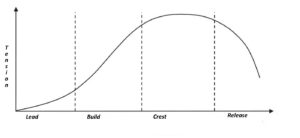Why me? Why this? Why now? Why am I feeling this way at all? Do I know how to deal with sadness for no reason? For a quick refresher course, try this.
There are times where sadness takes us. Sometimes the reason is clear – a person we know has died, or something we treasured becomes lost. But there are other times when intense sadness arrives apparently without a trigger – surprising and bottomless.
A thought experiment
Will you give yourself a moment to consider sadness in a new way? Just for this article, imagine all the sad memories you’ve accumulated throughout your lifetime as the cold, clear, pristine water you’d find in one of those old-style wishing wells. Got it?
Now, imagine that you are the well.
Does this imaginary sadness/memory/water fill the well completely? Overflow it?
Water wants to flow. Do you feel how the memory/water/sadness inside your well wants to escape in some way? There’s a limit to how full a well can get before it overflows and forms a stream.
We all have memories, and some of them are just sad. We are hardwired to store memories, probably starting with separation from our mothers at birth. When those memories play in the theatre of our mind, we also re-experience the feelings stored with them.
Feelings, like music, are meant to be played. To be experienced. We run into trouble when we refuse to experience feelings. Yes: there’s a difference between experiencing the feeling and expressing it in some tangible way, and we will get to that in a moment.
In your thought experiment, what is the depth of your well? Can you touch the surface? Maybe the water so far down that a bucket and rope won’t reach it.
The powerful awareness of emotion
To have this kind of awareness puts you in a place of power. But many of us don’t have such a visceral, tangible awareness of the sad memories we contain. It can be scary to get close to them. The thing is that if we ignore the memories and the feelings connected to them without draining the well? Eventually, all that water must go somewhere.
In your thought experiment, can you now see why we cry “for no reason,” or act out in some unexpected way? It’s only human to let feelings flow. Although this is just a thought experiment, take a few days to observe your own feelings as they arrive. You may come to a sudden inspiration: this is how it works best.
The reason
Overfill a well, or a glass, or a bowl, and the liquid spills. Overfill a human with feelings, and the feelings, too, can leak out and cause a mess. Mostly, sadness “for no reason” is related to a habit of stashing it inside, keeping a stiff upper lip, holding it in, forging ahead, staying the course: eventually, the dam will break and that sadness will reduce you to a puddle, at least temporarily.

And that’s OK.
There’s usually a trigger (sometime after the tears stop the trigger emerges) but it’s not always obvious when sadness arrives. That trigger – the one that comes clear sometime after the meltdown is over – is not the real reason for the sadness. The real reason for unexpected sadness? Holding on to too much sadness and too many sad memories.
It’s a cultural thing in individualistic societies such as America to be happy, have a nice day, don’t let the turkeys get you down whatever the cost, and to feel a certain sense of shame if you’re the sad one in a happy crowd. So we pretend to be happy while still secretly grieving the loss of a parent, for example. Bad form!
But now that you know the reason sadness surprises you, you can put your thought experiment to work in the real world by dealing intelligently with that reason.
No more double-stuff
Stuffing a jelly doughnut, or a turkey, or a cream puff is fine; double-stuffing a human heart with sadness isn’t. Our human emotional equipment has enormous bandwidth, but, like muscles, our emotional equipment can atrophy without exercise.
To exercise your feelings, you’ve got to experience them, but not necessarily express them.
Stuffing sadness down deep inside isn’t the same thing as exercising the healing, releasing, relieving, compassionate, self-care of allowing our emotional equipment to do what it does best: feel. Fully. Contrasted with anger or fear, sadness is a very benign feeling to experience. There’s a kind of cleansing peace that comes over me after I’ve had a good cry. How about you?
Instead of doing the sadness double-stuff and overflowing its container inside you, give your system a few minutes to really feel how sadness works within you. Do this privately if you can until it becomes more natural to allow tears to come in public. Use supportive music if that helps you cry. Give yourself the maximum experience of sadness. Do this as a ritual.
Sadness and belief systems
Any activity that lets the sadness well up and play on us, even if that’s sitting still, can be turned into a sadness rite. To ritualize the experience of sadness, just bring focus and intention to it. Whatever your belief system, a ritual experience of sadness might be nothing more than this:
“Sadness, I welcome you. I surrender to you. I allow you to work on me, to cry my tears, heave my chest, sob my voice, beat my heart, shake my spine. Sadness, I am with you now, completely.”
Many of us pray. Prayer can be a welcoming ritual for sadness. So can exercise.
There’s no reason for a particular belief system to stand in your way when it comes to feeling sad. Every monolithic belief system in common practice today allows sadness, and often that sadness is a necessary part of experiencing the sacred.
There’s nothing particularly holy or sacred about feelings – they are easy for neuroscience to explain – but the effect of fully-experienced feelings? That’s another thing. The experience of having a good cry may have neuro-scientific measurements, but there’s a more ethereal essence about it. A good cry can be a tool to invite a more holy, sacred, awareness.
The dark journey
Many mainstream religions teach both the necessity for a dark journey into night and the reward for making that journey: knowing God. This “dark night of the soul“ mythological journey pre-dates modern religion. The myth grew out of a collective need to express a common human transitional journey through the heart of darkness, whether that was to become an adult in some symbolic way or to approach the Divine.
The myth was later canonized as a foundational religious experience. Entering a cathedral, for example, is meant to symbolize our human return to the womb of Mother God. You can read this mythology in novels, poetry, movies, and the theatre, as well as in music and fine art. It’s a central act in the life journey of we homo sapiens.

The point here is that experiencing an unwanted feeling of sadness is something we have in common with millennia of our ancestors. We aren’t re-inventing the wheel on dealing with sadness! And there’s plenty of anecdotal evidence that allowing the feeling beats stuffing the feeling…every time.
Joy and sorrow
Joyous people are happy…and they also know sorrow. Exercising the happy limit and its counterpart, the sad limit, stretches the bandwidth of our emotional range. There are so many aspects to feelings, both the ones we like and the ones we don’t! Yes: feeling sad may not be as nice as feeling happy. But it’s unwise to cut off the healthy, natural experience of feeling by hiding the authentic experience of it or pretending to feel some other way that’s unrelated to and inappropriate for a particular trigger. Get sad and build your emotional muscles, people!
Just don’t let your sadness break things and hurt others.
Many belief systems encourage appropriate sadness. Wakes and funerals are rituals for sadness. Many indigenous cultures have a grief ritual where certain people cry for everyone in the community so that emotions aren’t dammed up inside the collective consciousness. Sometimes this purposeful keening can last for days if that’s what it takes to allow the sadness to flow fully.
Experience vs expression
Sadness and joy are often benign. They aren’t generally feelings that hurt others. Experience and expression of joy or sadness aren’t hurtful, although they can be contagious. Sharing a good laugh or communal tears are healthy human experiences of the expression of joy and sadness.
On the other hand, getting angry or fearful in combination with sadness is more complex. Those combination feelings can be experienced in safety just as plain old sadness can, but when it comes to the expression of anger and fear? Expression of those primal emotions can often lead to physical damage. We don’t want that!
So, be open to the experience of feelings like sadness just as you are open to experiences of joy. Express those feelings properly and often so that the well doesn’t fill up and leak out all over your scene. For guidance on experience and expression of fear and anger, check out this article (fear) and this one (anger).
Be well
I want to offer encouragement and support as you face sadness in this way. There’s an implied double entendre in the salutation “be well,” isn’t there? Being well includes finding ways to use the energy in those stored-up sad memories – the ones that are overflowing the well in the thought experiment from earlier.
Feel that stuff. Let it flow. Trigger it with sad music and allow that music to soundtrack a really good cry. To do that is good preparation for life and a healthy practice of being well.
Someone once said that the three hardest phrases to use are “I’m sorry,” “I love you,” and “I need help.” Don’t let any of those slow you down! Your guides are all around you and they are ready to smooth your path as you practice being well. Teachers, preachers, counselors, therapists, friends, family, even article writers with tons of experience in human emotion like me. Reach out. We are here.
Ready for a deeper dive? The Musimorphic Quest, a fully-mentored online active-learning experience will immerse you in practical ways to meet life’s challenges with skills you may not realize you already have. It’s not for everybody, but you are that unique individual who really resonates with with the power of music and wants to learn to wield it with skill, give it a try. The landing page is here.



